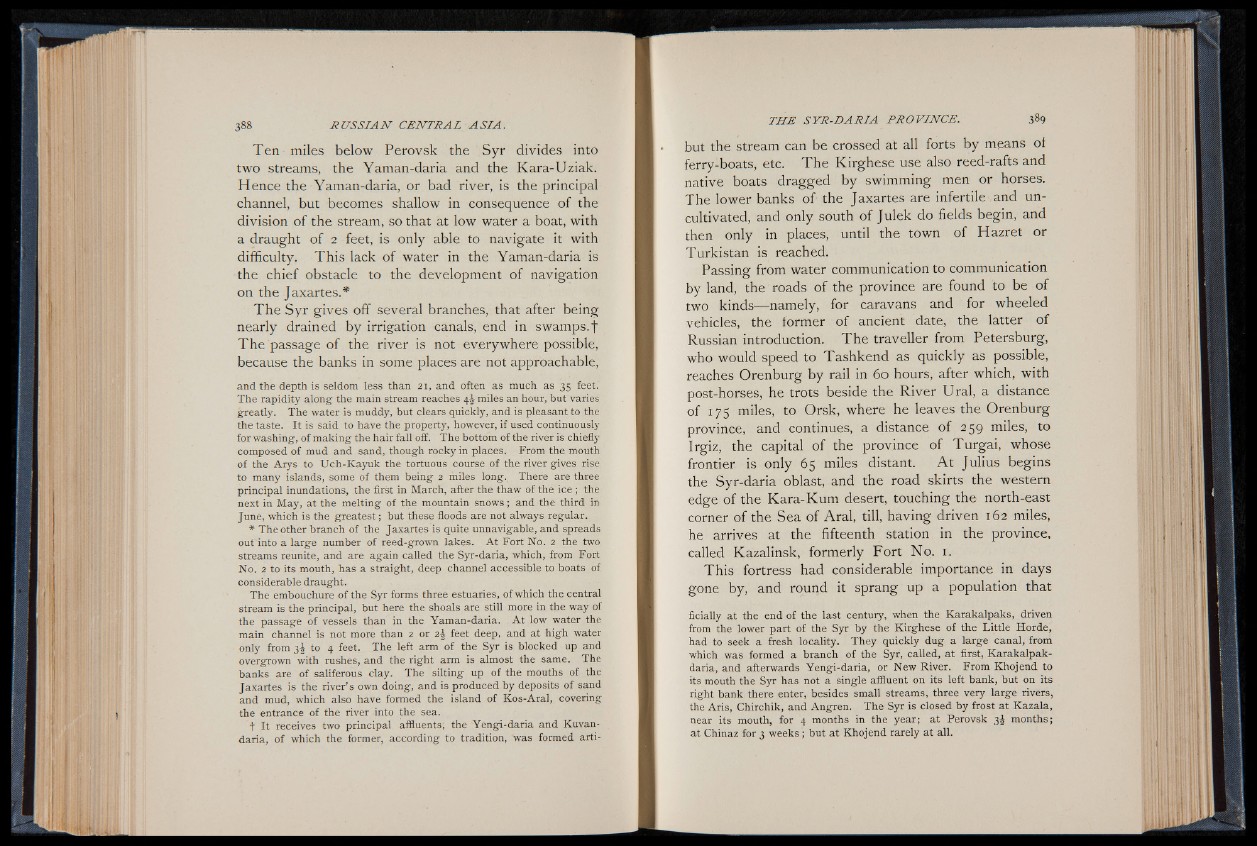
Ten miles below Perovsk the Syr divides into
two streams, the Yaman-daria and the Kara-Uziak.
Hence the Yaman-daria, or bad river, is the principal
channel, but becomes shallow in consequence of the
division of the stream, so that at low water a boat, with
a draught of 2 feet, is only able to navigate it with
difficulty. This lack of water in the Yaman-daria is
the chief obstacle to the development of navigation
on the Jaxartes.*
The Syr gives off several branches, that after being
nearly drained by irrigation canals, end in swamps.f
The passage of the river is not everywhere possible,
because the banks in some places are not approachable,
and the depth is seldom less than 21, and often as much as 35 feet.
The rapidity along the main stream reaches 4-J miles an hour, but varies
greatly. The water is muddy, but clears quickly, and is pleasant to the
the taste. It is said to have the property, however, if used continuously
for washing, of making the hair fall off. The bottom of the river is chiefly
composed of mud and sand, though rocky in places, From the mouth
of the Arys to Uch-Kayuk the tortuous course of the river gives rise
to many islands, some of them being 2 miles long.. There are three
principal inundations, the first in March, after the thaw of the ice ; the
next in May, at the melting of the mountain snows; and the third in
June, which is the g re a te s t; but these floods are not always regular.
* The other branch of the Jaxartes is quite unnavigable, and spreads
out into a large number of reed-grown lakes. A t Fort No. 2 the two
streams reunite, and are again called the Syr-daria, which, from Fort
No. 2 to its mouth, has a straight, deep channel accessible to boats of
considerable draught.
The embouchure of the Syr forms three estuaries, of which the central
stream is the principal, but here the shoals are still more in the way of
the passage of vessels than in the Yaman-daria. A t low water the
main channel is not more than 2 or 2$ feet deep, and at high water
only from 3^ to 4 feet. The left arm of the Syr is blocked up and
overgrown with rushes, and the right arm is almost the same. The
banks are of saliferous clay. The silting up of the mouths of the
Jaxartes is the river’ s own doing, and is produced by deposits of sand
and mud, which also have formed the island of Kos-Aral, covering
the entrance of the river into the sea.
t It receives two principal affluents; the Yengi-daria and Kuvan-
daria, of which the former, according to tradition, was formed artibut
the stream can be crossed at all forts by means of
ferry-boats, etc. The Kirghese use also reed-rafts and
native boats dragged by swimming men or horses.
The lower banks o f the Jaxartes are infertile and uncultivated,
and only south of Julek do fields begin, and
then only in places, until the town of Hazret or
Turkistan is reached.
Passing from water communication to communication
by land, the roads of the province are found to be of
two kinds— namely, for caravans and for wheeled
vehicles, the former of ancient date, the latter of
Russian introduction. The traveller from Petersburg,
who would speed to Tashkend as quickly as possible,
reaches Orenburg by rail in 60 hours, after which, with
post-horses, he trots beside the River Ural, a distance
of 175 miles, to Orsk, where he leaves the Orenburg
province, and continues, a distance of 259 miles, to
Irgiz, the capital of the province of Turgai, whose
frontier is only 65 miles distant. A t Julius begins
the Syr-daria oblast, and the road skirts the western
edge of the Kara-Kum desert, touching the north-east
corner of the Sea of Aral, till, having driven 162 miles,
he arrives at the fifteenth station in the province,
called Kazalinsk, formerly Fort No. 1.
This fortress had considerable importance in days
gone by, and round it sprang up a population that
ficially at the end of the last century, when the Karakalpaks, driven
from the lower part of the Syr by the Kirghese of the Little Horde,
had to seek a fresh locality. They quickly dug a large canal, from
which was formed a branch of the Syr, called, at first, Karakalpak-
daria, and afterwards Yengi-daria, or New River. From Khojend to
its mouth the Syr has not a single affluent on its left bank, but on its
right bank there enter, besides small streams, three very large rivers,
the Aris, Chirchik, and Angren. The Syr is closed by frost at Kazala,
near its mouth, for 4 months in the year; at Perovsk 3^ months;
at Chinaz for 3 weeks ; but at Khojend rarely at all.